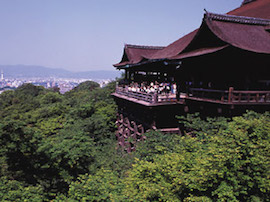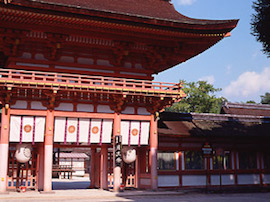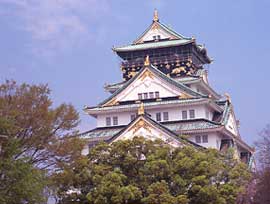
Southern Kyoto
The south side of Kyoto is recommended for such sightseeing locations as Fushimi Inari Taisha Shrine and Uji.
Fushimi Inari Taisha Shrine
Fushimi Inari Taisha Shrine is the head shrine of Inari Shinto, which includes about 30,000 shrines dedicated to the worship of Inari, the god of grain and fertility. The year 2011 saw the 1,300th anniversary of the Fushimi Inari Taisha's enshrinement. During the traditional New Year's shrine visiting season, it gets the most pilgrims of any shrines and temples in the Kinki region. From the back of the main shrine leading to Mount Inari is a mystical corridor called "One Thousand Torii" made of more than 5,000 red torii gates.
The hike to the summit of Mount Inari is about a three-hour hike, and you can enjoy teahouses and wonderful views along the way. The way is enjoyable even for those not wishing to go the entire route. On the shrine grounds is a stone dragon that divines whether people will achieve their heart's desire. Come to Fushimi Inari Taisha and try your luck! The divine messenger is the fox, and statues representing the fox stand on both sides of Romon (Tower Gate).
Among the interesting things to see are ema, traditional horse votive tablets but formed in the shape of a fox, fox-shaped rice crackers sold on the approach to the shrine and other fox motifs.
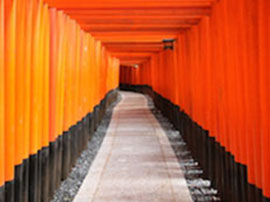
| Open hours: |
8:30 a.m. to 4:30 p.m. |
|---|---|
| Admission: |
There is no admission charge to the grounds. |
| Address: | 68 Fukakusa Yabu no Uchi-cho, Fushimi-ku, Kyoto, Kyoto Prefecture |
| URL: | http://inari.jp/en/ |
| Phone: | +81-(0)75-641-7331 |
| Access: |
• Take Keihan Electric Railway to Fushimi-Inari Station. It is a five-minute walk. • Take the JR Nara Line to Inari Station. It is a three-minute walk. |
Tofuku-ji Temple
When the subject of famous places in Kyoto for autumnal leaves is brought up, Tofuku-ji Temple is the first name that comes to mind. The name Tofuku takes the first part of its name "to" from Todai-ji Temple for its massive scale, and "fuku" from Kofuku-ji Temple for its teachings and practices. Although formerly known as a place for cherry blossoms, the monks cut down the cherry blossom trees in the Muromachi period because of concerns that admirers would disturb their practice. In their place, maple trees multiplied until they reached the count today of some two thousand.
In fall, many tourists come to Tsuten-kyo Bridge, the crossing of which is like crossing a sea of beautiful autumnal leaves. When you stand on the bridge, the colorful leaves completely blanket the ravine, a scene so astounding, it will take your breath away. But the autumn foliage is not the only wonderful thing to see at Tofuku-ji Temple. Garden of the Hojo (the Abbot's Hall), made up of gardens surrounding the building to the east, west, south and north, is famous worldwide as an ideal example of modern Zen gardens.
The North Garden, with its vividly colored moss and paving stones arranged in a checkered pattern, and the South Garden with its dynamic dry landscape representation of Shinsen-to Island, where the immortal sennin are said to live, are both novel and modern.
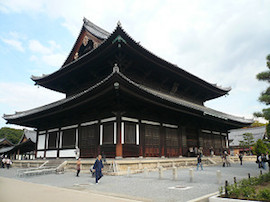
| Open hours: |
April to end of October: 9:00 a.m. to 4:00 p.m. November to early December: 8:30 a.m. to 4:00 p.m. Early December to end of March: 9:00 a.m. to 3:30 p.m. |
|---|---|
| Admission: |
There is no admission charge to the grounds. Admission for Tsuten-kyo Bridge, Kaisan-do Hall, Garden of the Hojo (the Abbot's Hall): Adults: 400 yen Elementary and junior high school students: 300 yen |
| Address: | 15-778 Honmachi, Higashiyama-ku, Kyoto, Kyoto Prefecture |
| URL: | http://www.tofukuji.jp/english/index.html |
| Phone: | +81-(0)75-561-0087 |
| Access: |
• Take Keihan Electric Railway to Tofuku-ji Temple. It is a 10-minute walk. • Take the JR Nara Line to Tofuku-ji Station. It is a 10-minute walk. |
Byodo-in Temple
A World Heritage Site. Uji Palace was built as a villa by Fujiwara no Michinaga, the most powerful figure of the Heian Period. It was converted to a temple by Fujiwara's son Yorimichi in 1052 and the Amida Hall was added. The Amida Hall is intended to reproduce the Pure Land (paradise) in this world and is called Phoenix Hall because the building can be seen as a phoenix spreading its wings. Inside is enshrined a sedentary statue of Amida Nyorai (Amitabha), a National Treasure.
The Amida Hall has come through much wartime destruction, miraculously surviving without damage. The architecture, Buddhist statues, paintings, gardens and more, convey traditions to us from the eleventh century, the second half of the Heian Period. The bell on the temple grounds was made in the eleventh century and is counted among the three great bells of the world. All of its surfaces are covered with exquisite designs such as angels, lions and arabesques in relief.
The back of the 10-yen coin has the Amida Hall, and the 10,000-yen note depicts a phoenix on the roof of the Amida Hall. Many people enjoy comparing those to the real things at Byodo-in Temple. From the end of April to the start of May, the blooming wisteria flowers on the temple grounds are the pride of the temple.

| Open hours: |
Garden: 8:30 a.m. to 5:30 p.m. Byodoin Museum Hoshokan: 9:00 a.m. to 5:00 p.m. Phoenix Hall: 9:10 a.m. to 4:10 p.m. Note: Admission starts at 9:30 a.m. and 50 persons at a time every 20 minutes thereafter |
|---|---|
| Admission: |
Adults: 600 yen Junior high and high school students: 400 yen Elementary school students: 300 yen Entrance to the Phoenix Hall: 300 yen |
| Address: | 116 Uji Renge, Uji, Kyoto Prefecture |
| URL: | http://www.byodoin.or.jp/en/index.html |
| Phone: | +81-(0)774-21-2861 |
| Access: |
• Take the Keihan Electric Railway Uji Line to Uji Station. It is a 10-minute walk. • Take the JR Nara Line to Uji Station. It is a 15-minute walk |
Attractions along the Keihan line
Discount Tickets
When using Keihan Electric Railway, passes for visitors to Japan are a convenient way to get around. Not only do you get unlimited rides on Kyoto and Osaka lines, the passes come with a number of other benefits. For travel in Osaka and Kyoto, these passes are indispensable!

